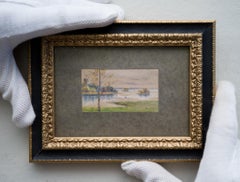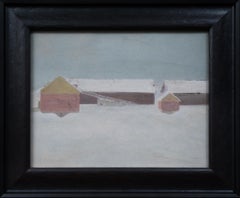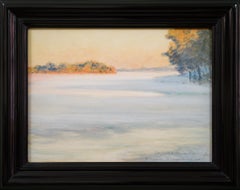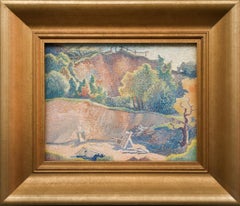Video Loading
Want more images or videos?
Request additional images or videos from the seller
1 of 9
Oskar BergmanMiniature Landscape Called Birch Trees Reflected in a Stream by Oskar Bergmanc. 1905-1915
c. 1905-1915
$5,298.42List Price
About the Item
- Creator:Oskar Bergman (1879 - 1963, Swedish)
- Creation Year:c. 1905-1915
- Dimensions:Height: 5.52 in (14 cm)Width: 4.34 in (11 cm)
- Medium:
- Period:
- Condition:Very good condition, with bright and clear colors. We've replaced the old glass with a UV protected non-reflective glass.
- Gallery Location:Stockholm, SE
- Reference Number:1stDibs: LU1445214479212
About the Seller
5.0
Platinum Seller
Premium sellers with a 4.7+ rating and 24-hour response times
Established in 2020
1stDibs seller since 2020
199 sales on 1stDibs
Associations
International Confederation of Art and Antique Dealers' Associations
Authenticity Guarantee
In the unlikely event there’s an issue with an item’s authenticity, contact us within 1 year for a full refund. DetailsMoney-Back Guarantee
If your item is not as described, is damaged in transit, or does not arrive, contact us within 7 days for a full refund. Details24-Hour Cancellation
You have a 24-hour grace period in which to reconsider your purchase, with no questions asked.Vetted Professional Sellers
Our world-class sellers must adhere to strict standards for service and quality, maintaining the integrity of our listings.Price-Match Guarantee
If you find that a seller listed the same item for a lower price elsewhere, we’ll match it.Trusted Global Delivery
Our best-in-class carrier network provides specialized shipping options worldwide, including custom delivery.You May Also Like
Récupérant Du Carburant Pour L’Hiver Gathering Winter Fuel The Great War Period
Located in Sutton Poyntz, Dorset
Gaston Cornil.
French ( b.1883 - d.1940 ).
Récupérant Du Carburant Pour L’Hiver (Gathering Winter Fuel).
Watercolor & Gouache On Buff Paper.
Signed Lower Left.
Image size 12.4 inches...
Category
Early 20th Century Impressionist Landscape Drawings and Watercolors
Materials
Watercolor, Gouache, Paper
$1,220
H 19.69 in W 21.66 in D 0.79 in
View of the Ovo Castle in the Moonlight, a 19th century Neapolitan gouache
Located in PARIS, FR
Neapolitan gouaches appeared in the eighteenth century when tourism in the Naples area was developing: the discoveries of Herculaneum and Pompeii made this city a mandatory stop on the Grand Tour, the journey made by wealthy Europeans to complete their education.
Generally small in size for ease of transport and affordable in price, these gouaches were the ideal travel souvenir that these tourists of the early days were bringing back to capture the idyllic landscapes they had discovered during their journey and to share them with family and friends upon their return at home.
The Bay of Naples and the eruptions of Vesuvius are the favourite themes of these views. Here we have a view of the Ovo Castle, which was rebuilt on the island of Partenope, in the middle of the Bay of Naples and about a hundred metres from the shore by the Normans in the 12th century on antique ruins...
Category
Early 19th Century Romantic Landscape Drawings and Watercolors
Materials
Gouache, Paper
$1,445
H 12.19 in W 14 in
Original 70's Hand Painted Textile Design Gouache Green Shades on White Paper
Located in ALCOY/ALCOI, ES
We offer a small number of these original illustration designs by this design studio based in Alcoy (Spain), which could pair well or make group sets if buyers so desired. Designed t...
Category
1970s Modern Landscape Drawings and Watercolors
Materials
Paper, Gouache
$1,023
H 0.12 in W 18.9 in D 34.65 in
Pond Friend, 2020, watercolor, oil pastel, green, frame, landscape, fantasy
By Shamona Stokes
Located in Jersey City, NJ
Watercolor on paper, framed. Pond Friend, 2020, watercolor, oil pastel, green, frame, landscape, fantasy, blue, creature. Framed and matted, frame size measures 24" x 35.75" x 1.25"
...
Category
2010s Contemporary Landscape Paintings
Materials
Paper, Watercolor, Oil Pastel, Ink, Acrylic
Price Upon Request
H 22.5 in W 29.75 in D 0.125 in
Gift, 2020, watercolor, oil pastel, pink, orange, rabbit, ink, fantasy
By Shamona Stokes
Located in Jersey City, NJ
Gift, 2020, watercolor, oil pastel, pink, orange, ink, fantasy, rabbit.
Hand signed by artist
Certificate of Authenticity included
Framing available
Category
2010s Contemporary Landscape Paintings
Materials
Paper, Oil Pastel, Ink, Watercolor, Graphite
Price Upon Request
H 29.75 in W 22.5 in D 0.125 in
Dark Night, 2020, watercolor, oil pastel, black, frame, landscape, fantasy, blue
By Shamona Stokes
Located in Jersey City, NJ
Watercolor on paper, framed. Dark Night, 2020, watercolor, oil pastel, black, frame, landscape, fantasy, blue, creature. Framed and matted, frame size measures 24" x 35.75" x 1.25"
...
Category
2010s Contemporary Landscape Paintings
Materials
Paper, Oil Pastel, Ink, Watercolor, Gouache, Color Pencil
Shamona StokesDark Night, 2020, watercolor, oil pastel, black, frame, landscape, fantasy, blue, 2020
Price Upon Request
H 22.5 in W 29.75 in D 0.125 in
Hopeful Spring, 2020, watercolor, oil pastel, green, landscape, fantasy, trees
By Shamona Stokes
Located in Jersey City, NJ
Hopeful Spring, 2020, watercolor, oil pastel, green, landscape, fantasy, trees.
Hand signed by artist
Certificate of Authenticity included
Framing available
Category
2010s Contemporary Landscape Paintings
Materials
Paper, Oil Pastel, Ink, Acrylic, Watercolor, Color Pencil, Graphite
Price Upon Request
H 29.75 in W 22.5 in D 0.125 in
Costal Watercolor Seascape
By Borja Fernandez
Located in Austin, TX
By Borja Fernandez
This coastal European seascape features rocky tan cliffs with purple and blue water below. This scene depicts the coast of Mallorca, Spain.
Category
21st Century and Contemporary Landscape Drawings and Watercolors
Materials
Watercolor, Archival Paper
"Trees with Flowers and Fruits" Eva Peron Mural Sketch
Located in Austin, TX
By Gustav Likan
This pieces is from the Eva Perón commissioned mural sketch collection from Likan's time as a commissioned artist in Argentina between 1950 and 1952.
6.5" x 8" Water...
Category
1950s Landscape Paintings
Materials
Archival Paper, Watercolor
Visiting Friends - 21st Century, Contemporary, Landscape, Watercolor on Paper
By Ekaterina Smirnova
Located in Barcelona, Catalonia
Watercolor on paper
Atmosphere -masses of evaporating water in the air- describes Ekaterina Smirnova's paintings best. Working in watercolour, Smirnova has a unique approach to this ...
Category
21st Century and Contemporary Contemporary Landscape Drawings and Waterc...
Materials
Paper, Watercolor
$10,235
H 31.5 in W 70.87 in
More From This Seller
View AllLate Autumn, Beautiful Small Landscape Watercolor by Fanny Hjelm
Located in Stockholm, SE
This enchanting watercolor, measuring a mere 4.5 x 8 cm, offers a glimpse into the beauty of a serene autumn landscape overlooking Lake Möckeln, nestled between the municipalities of Degerfors and Karlskoga in the province of Värmland, Sweden.
In this picturesque scene, the horizon reveals the serene outline of the distant shoreline, adorned with several small islands. The tranquil waters mirror the reflection of the trees on the land, creating a harmonious and captivating play of colors. In the foreground, a solitary birch tree stands tall, adding depth and perspective to this miniature watercolor.
The level of precision achieved within this tiny format is truly remarkable, showcasing Fanny Hjelm...
Category
1920s Landscape Drawings and Watercolors
Materials
Paper, Watercolor
Barns Buildings at Ruds Säteri, Värmland, Sweden, 1900
Located in Stockholm, SE
Hilding Werner (1880-1944) Sweden
Barns Buildings at Ruds Säteri, 1900
watercolor on paper
unframed 21.5 x 31 cm (8.46 x 12.2 inches)
framed 22 x 40 cm (8.66 x 15.75 inches)
...
Category
Early 1900s Landscape Drawings and Watercolors
Materials
Paper, Watercolor
Winter Landscape, 1908, Watercolor
Located in Stockholm, SE
This watercolor by Robert Thegerström, a Swedish painter, draftsman, and graphic artist, captures a serene winter scene from 1908. The artwork presents a frozen lake bathed in warm s...
Category
Early 1900s Naturalistic Landscape Drawings and Watercolors
Materials
Watercolor, Laid Paper
A Colorful Pointillist Landscape by the Cliff, c. 1935
Located in Stockholm, SE
This painting, created around 1935, showcases Axel Olson's experimentation with surrealism during the 1930s. Executed with a technique reminiscent of pointillism, the artwork capture...
Category
1930s Surrealist Landscape Drawings and Watercolors
Materials
Gouache
Evening Glow by the River, 1917
Located in Stockholm, SE
This evocative pastel painting by Victor Jernbergh, dated 1917, captures the serene and enchanting scene of a river at dusk. The central composition is dominated by a lone pine tree ...
Category
1910s Symbolist Landscape Paintings
Materials
Paper, Pastel
Northern Light: A Winter Scene from Ljusdal
Located in Stockholm, SE
We are delighted to present this enchanting winter landscape by the Sundsvall-born artist Oscar Lycke. Executed in 1911, Motif from Ljusdal captures the serene beauty of a snow-cover...
Category
1910s Naturalistic Mixed Media
Materials
Paper, Watercolor, Chalk, Ink
Recently Viewed
View AllMore Ways To Browse
Oskar Bergman
Rothenburg Tauber
South Pacific Painting
Tadashi Hayakawa
Tatton Winter
Watercolor Redwoods
Bert Van Bork
Charles Criner
Church Architectural Drawings
Desert Mountain Landscape Watercolor
Emma Mendenhall
George Chinnery
John Linfield
Justin Faivre
Leonardo Cremonini
M Vernon
Maria Ada Gianni
Retro Donald Art Company



